🎗️Lonny's War Update- October 680, 2023 - August 16, 2025 🎗️
🎗️Day 680 that 50 of our hostages are still in Hamas captivity🎗️
The Only Deal Acceptable is a Full Deal that Ends the War - by Dr. Gershon Baskin
August 15, 2025
The Israeli news reported this evening that Hamas has agreed to return to negotiate what was called “the Witkoff Deal” – the bad deal that brings home half of the Israeli hostages (dead and alive) and a ceasefire that will last 60 days. To the best of my knowledge this is a lie. When the negotiations on the 60-day ceasefire took place last month and months before, Hamas did not understand why Israel insisted on demanding only half of the hostages – why not all of them? It became clear to them that the reason was that Netanyahu refused to end the war and therefore, Israel would not negotiate for all of the hostages. Hamas was really confused because for more than a year Hamas had made it clear that only ending the war and Israel completely withdrawing from Gaza would bring about a release of all of the hostages.
In October 2024, I was in Doha and heard from the Qatari mediators that Hamas was prepared to release all of the hostages in exchange for the same demands that they have today: ending the war, no Israeli soldiers in Gaza, an agreed release of Palestinian prisoners, significant increase of humanitarian aid coming into Gaza and distributed by the international organizations. Even then, as today, and as I had received from Hamas in August 2024, in writing in Arabic and English, a statement that Hamas would not govern Gaza any longer and that a professional technocratic Palestinian government would be established and given all authorities and it would not include Hamas.
During all of the past week, members of the Hamas negotiating team, including the head of the team, Khalil al Haya, were in Cairo where they met with the Egyptian intelligence, including its head, and with Qatari mediators who also were in Cairo. Throughout the week, the Hamas team was told by the mediators that Israel will only agree to a partial deal and not “an end of war deal”. Then they heard Netanyahu say that Israel would only accept a full deal that releases all of the hostages. They also heard that the head of Mossad was in Qatar and told the Qataris that Israel would only agree to a comprehensive deal that releases all of the hostages. The Hamas team was even more confused. The mediators were pushing them for a partial deal but they thought that Netanyahu was only interested in a full comprehensive deal. But then Netanyahu kept speaking about conquering all of Gaza and he said that Israel would hold sovereignty over all of the West Bank and spoke about Greater Israel.
There is no mystery here. Netanyahu is still trying to sell us the same old lie that Israel will bring Hamas to its knees and then all of the hostages will come home. Israel told the mediators that it would only accept a partial deal, only to drag the negotiations on while the war continues. Netanyahu has absolutely no intention of making any deal with Hamas and Hamas will never surrender to Israel. In the meantime, Netanyahu has convinced President Trump that if Israel withdraws from Gaza, Hamas is the only armed force that will continue to control Gaza and then it will rebuild its forces and threaten Israel again. Even though Hamas is decimated and has no real military ability to threaten Israel, and all of its political leaders and most of its military commanders are dead, Netanyahu continues to scare the Israeli public (and President Trump) that October 7 could happen again. That pretty much convinced Trump which is when the US President said “Israel will do what Israel needs to do. It’s an Israeli decision”. The release of the videos of Israeli hostages Rom Braslovsky and Eviatar David in which they looked like victims of concentration camps from World War II, starved and close to death, pushed Trump over the edge. Trump saw those videos and decided that Israel should continue to destroy Hamas until the end. Trump was very emotionally moved by those videos and if before seeing them there was a chance that Trump would tell Netanyahu to end the war and to “get it done”, after seeing them, Trump was much more inclined to allow the war to continue – as long as Israel allowed more food into Gaza. Witkoff was sent to Israel to make sure that would happen and he even went to one of the Gaza Humanitarian Foundation distribution sites to see it with his own eyes.
From what I have heard from senior American personnel involved in the negotiations is that the US wants the war to end. But they do ascribe to the claim that Netanyahu raised in his meetings with Trump – there is no acceptable viable Palestinian or Arab alternative to Hamas in Gaza. While it clear that Netanyahu doesn’t want any viable Gaza Palestinian or Arab government to appear and get the support of the region and of the US as well as the support of the Palestinian people themselves, it seems that the Americans do want this to happen. But from my vantage point, despite what has been reported a little bit in the Israeli press, it will not come from a US initiative. Egypt has been working on this for quite some time. A senior person in Hamas, as well as another well-known non-Hamas Palestinian leader told me that all of the Palestinian factions have met several times, in Cairo, and have agreed on a Palestinian Gaza governing council – including the names of the people who should be on the council. But this is still not happening and if Hamas and the Palestinian leadership in Ramallah want to end the war, they need to convince Trump that the solution for who will govern Gaza and what will happen with the remaining Hamas armed personnel is solved and reasonable and can be acceptable.
In the negotiations in Cairo and Doha, the Hamas representatives are constantly debating on what Israel will accept and what Israel will reject. They are constantly discussing with the mediators the boundaries of their own demands with respect to Israel’s demands. Israel isn’t in the room and yet Israel’s red lines and Israel’s demands are the subject that they are discussing. What Hamas does not yet understand is that they need to see only one person in the room and that is Donald Trump. They really don’t need to negotiate with Israel – at least not at this point. If Hamas indeed wants to end the war and for Israel to get out of Gaza, they need to take the initiative and draw up a plan that not only includes releasing all 50 of the Israeli hostages in 24-48 hours (as they have said), and not only includes the release of Palestinian prisoners (on which they say they are willing to be more flexible in their demands), and not only ends the war and leads to a full Israeli withdrawal from Gaza, they need to clearly demonstrate that their role in governing Gaza is over, and that the long-term ceasefire means that Hamas will no longer have a military wing in Gaza.
Israel will not withdraw from all of Gaza without there being a fully functional new Palestinian government in Gaza committed to a long-term ceasefire without any ability to build a military force and accumulate or manufacture weapons. The new Palestinian government, according to what Arab leaders and leading Palestinians say, will invite an international Arab-led security presence to come to Gaza to help to build law and order and to remove all threats of attacks from Gaza against Israel and all attacks by Israel against Gaza. This will not happen overnight – it will take time. But a full and comprehensive agreement to end the war can happen immediately. The end of the war can be declared. All hostages can be released in 24-48 hours coordinated with the release of Palestinian prisoners. Israel can withdraw in phases over a relatively short period of time. Egypt is in the process now of training 5000 Palestinian police cadets that can be deployed to Gaza in a short period of time. With an agreed time-frame, Israel can withdraw to the border and establish a no-entry perimeter zone all along the 45-kilometer-long Israel-Gaza border while being deployed on the Israeli side of the border. In this no-entry zone of 500-750 meters depth, there will be “shoot to kill” policy until the time comes when there really is no threat from Gaza. Hamas will agree to this because there will no longer be Israeli soldiers in Gaza. In the absence of Israeli soldiers, there are also no Israeli soldiers to be shot at by armed Hamas personnel.
There will be no international and Arab money coming into Gaza for reconstruction as long as Hamas remains in power and the new Palestinian non-Hamas government is up and running. Hamas knows this as well. Food and medical supplies will flood Gaza as soon as possible, through international organizations and the Gaza Humanitarian Foundation will be canceled and will return to the United States. This is all possible if Hamas can convince President Trump that their proposal to end the war, to release all of the hostages and to cease all aggression against Israel is genuine. Hamas could begin by feeding the hostages, and releasing videos of hostages receiving medical care and food and clean water – not on a one-time basis for the purpose of filming them – but until the agreement is concluded and they are all released. Hamas claims that the people are Gaza are being starved and that the hostages get the same treatment as the Gazans get. Whether or not this is true, their starving the hostages is counterproductive to the Hamas claim that they want the war to end.
There is only one person in the world who can make this war end and that is Donald Trump. Hamas needs to address their initiative and propose to end the war to President Trump. Hamas also knows very well that they need to give their proposal directly to the Prime Minister of Qatar because he is the one who will tell the Americans if Hamas is serious and genuine in what they are proposing. And if there are readers who are bewildered by the Americans taking the word of the Qataris at face values after Qatar funded and hosts Hamas, and Al Jazeera is the voice of Islamic extremism, well that is the very bizarre reality of the world today, of the region, of Israel and Hamas. Trump trusts the Qataris.
Ending the war in Gaza is enough for President Trump to get the Nobel Peace Prize and he would deserve it. When this war is over, we the people of Israel and the people of Palestine have to get our own political houses in order. We need to oust all of the current leaders and find new leaders who will be willing to guarantee that the Gaza war will be the last Israeli-Palestinian war. When that happens the people of Israel and the people of Palestine will get a much more valuable prize than the Nobel - we will all enjoy the freedom, liberation, security and dignity that we all need. And it should be understood and neither side will get it if both sides don’t get it. link
Hamas negotiators signal willingness to come down from demands that caused talks to collapse — officials
Hamas negotiators in Cairo this week have signaled a willingness to come down from demands they made last month that led to the collapse of hostage talks in Doha, an Israeli official and an Arab diplomat familiar with the matter tell The Times of Israel.
Arab mediators have passed along the development to Israel, but Jerusalem has responded that it is not interested in another partial ceasefire and is only willing to forgo its plans to take over Gaza City if Hamas agrees to all of its demands for ending the war, the Israeli official says.
Those demands include the release of all 50 remaining hostages, the disarmament of Hamas and the demilitarization of the Gaza Strip.
But the gaps on those issues are very wide, particularly regarding the disarmament of Hamas, with the Arab mediators believing that it is a “poison pill” designed to blow up the talks, as it will likely require ongoing intensive Israeli military operations in Gaza in order to verify that it is being upheld, the Arab diplomat says.
Instead, the Arab mediators prefer a gradual approach to dealing with Hamas’s weapons, akin to the system that is in place in Lebanon. Arab countries are willing to contribute troops to this effort on the condition that it is at the invitation of the Palestinian Authority, the diplomat recalls.
But another one of Israel’s conditions for ending the war is barring any PA role in the governance of Gaza, effectively preventing the Arab initiative from moving forward.
Despite opposition from Jerusalem, Egyptian and Qatari mediators are planning to resume talks with Hamas on Saturday aimed at getting the group’s final approval on an updated proposal that is far closer to the one that the US and Israel authorized last month.
While it has been characterized as a partial deal, the Arab diplomat stresses that it still has the potential to turn into a permanent ceasefire if the sides hold successful negotiations during the envisioned 60-day truce. During that two-month period, 10 living hostages and 18 bodies will be released in exchange for an agreed-upon number of Palestinian security prisoners.
The US and Israel pulled their negotiators out of Doha last month due to frustration over Hamas’s demands regarding the scope of the IDF’s withdrawal from Gaza, the humanitarian aid mechanisms that will be in place during the truce and the number of Palestinian security prisoners it was demanding, the Israeli official says.
If Hamas gives its final approval of a softened proposal that comes down from those demands in the coming days, the mediators will present it to Israel, forcing Prime Minister Benjamin Netanyahu to decide whether to retreat from his declarations that he will no longer accept partial deals.
If he agrees to walk back those assertions, the sides will still have to hold another round of talks to agree on the Palestinian security prisoners to be released in the deal, the Arab diplomat clarifies.
The Israeli official says that the security establishment will likely urge the political echelon to take the deal, as it will secure the release of at least 10 living hostages, whereas the Gaza City takeover will risk the lives of some of those captives, with no guarantee that the military pressure will lead Hamas to capitulate.
Netanyahu currently feels that Hamas is buying time by expressing interest to mediators in a partial deal when it is not actually serious and that only military pressure will secure the release of all remaining hostages, the Israeli official adds.
Meanwhile, Channel 12 reports that Netanyahu received a “dramatic” document from who the network dubbed as a “professional” source involved in the negotiations, expressing in writing Hamas’s willingness to reach a partial deal after the terror group long insisted that it would only release additional hostages in exchange for an up-front Israeli commitment for a permanent ceasefire.
While Hamas appeared to forgo that demand earlier this summer, its subsequent demands were rejected by Israel and the US, leading to the talks’ collapse.
The Arab diplomat argues that Israel raised new demands of its own in June relating to the scope of its withdrawal that led the talks to drag out before the US eventually convinced Netanyahu to come down from them. But by then, Hamas came back with new demands of its own, and the window of opportunity for a deal was missed, the diplomat says. Link
- Police strip-searched three more women arrested at demonstration — report
Lawyer says search was legally unjustified and violated protesters’ rights, police maintain it was routine; 18 similar complaints filed recentlyPolice strip-searched three female protesters after their arrest Thursday night at a Tel Aviv demonstration demanding a Gaza hostage deal, according to a Friday report.
Protestors block a road during an anti-government rally calling for action to secure the release of Israeli hostages held captive since the October 7, 2023, Hamas-led attack in Tel Aviv on August 12, 2025. (Jack GUEZ / AFP)The women were arrested on suspicion of disorderly conduct, Haaretz said, a charge that doesn’t typically lead to strip-searches, even though police have the authority to conduct them.
The women were arrested with two other men who were not strip-searched, the paper said.
Two of the protesters said that they were required to pull down their pants and lift their shirts.
Efrat Safran, one of the detainees, told Haaretz they were warned that “’If you resist, we’ll use reasonable force.’ We were left with no choice but to comply.”
Safran added that this was her fourth protest-related arrest, but she had never previously been asked to undress. Another detainee said the officer justified the search as necessary to ensure she was not a danger to herself or others.
According to the report, police said the search was a lawful and routine procedure, applied to all detainees, to prevent detainees from having objects that could harm them or others in the holding cell.
The protesters’ lawyer argued that since the detainees were suspected only of public order offenses, which do not legally justify a strip search, the procedure was an unnecessary violation of their rights.Mounted police face off with Anti-government, pro-hostage deal protesters on the Ayalon Highway in Tel Aviv, August 9, 2025. (Yael Gadot/Pro-Democracy Protest Movement)
Eighteen complaints have been filed against police in the past month over partial strip searches of protesters.
Last week, Channel 12 reported that three women were strip-searched after being detained for blocking a road during an anti-government protest in Tel Aviv.
Another man who was arrested for the same reason was asked only to lift his shirt but was not strip-searched, the network said, noting that officers are entitled to perform strip searches only where they have a reasonable suspicion that justifies it.
Police told the network that “the search was done in accordance with the authority granted to officers.” link This is not the Israel Police; this is the Ben Gvir Militia that is against democracy, against anyone who speaks out against him and this corrupt government and anyone who is not on his side. The police brutality against demonstrators is not new and not an invention of Ben Gvir, but it has gotten progressively worse, more violent and with the police on the ground creating new laws that they act on against anti government and hostage supporting demonstrators. No one should be surprised by the impact of Ben Gvir on the police as the writing was clearly on the wall in bold type. But all that means is that we all need to fight harder against these fascists and the prime minister who enables all of it to occur. - Thousands to rally for hostages ahead of Sunday’s planned nationwide strikeDemonstrations in Tel Aviv will feature speeches by family members of captives, victims of October 7, as activists hope to bring country to a halt to pressure government on deal
Families of Israeli hostages are calling on the public to take to the streets on Saturday evening in support of the 50 hostages held in Hamas captivity for nearly 700 days, followed by a nationwide strike planned for Sunday.
Protesters block the Ayalon Highway in Tel Aviv at a demonstration calling to free the hostages and end the war in Gaza, on August 14, 2025. (Danor Aharon/Pro-Democracy Protest Movement)The central weekly protest will take place at Hostages Square outside the Tel Aviv Museum at 8 p.m. Addressing the crowd will be Dana Silberman Sitton, sister and aunt of murdered hostages Shiri, Kfir and Ariel Bibas; Itzik Horn, father of Eitan Horn and captivity survivor Iair Horn; captivity survivor Noga Weiss, daughter of murdered hostage Ilan Weiss; and Mor Godard, daughter of murdered hostage Manny Godard, who was supposed to have celebrated his 75th birthday on Friday.
Pushpa Joshi, sister of Nepali agricultural volunteer Bipin Joshi, will also address the crowd in English. Joshi was taken captive from Kibbutz Alumim on October 7. His mother and sister landed in Israel on Monday for their first visit since his abduction.
“Fifty hostages have been held in Hamas’s death tunnels for nearly 700 days. We have all seen, with our hearts torn, the images of Evyatar David and Rom Breslavsky suffering under unimaginable human torment,” said a statement from the Hostages and Missing Families Forum.
“Now is the time to act: to take to the streets, support the families of the hostages, support the families of the soldiers, and influence the future of the hostages and the future of the country — because only the people can bring the hostages home,” the statement continued.
The demonstrations will be followed by a planned nationwide general strike on Sunday, organized by the October Council, which represents some family members of those held hostage in Gaza or whose family members have been killed in the fighting.
Families called the strike to protest the government’s decision to expand the war in Gaza with a new offensive rather than sign a deal to return the abductees.
Hundreds of local authorities, businesses, universities, tech companies, and organizations will join the strike.
Pinchas Idan, the chair of the Airports Authority employees’ union, has stated that they will do their best to ensure that passengers are not affected, despite some workers planning to strike.
Anat Angrest, mother of Hamas hostage Matan Angrest, calls for a general strike against the Gaza war at a press conference in Tel Aviv on August 10, 2025 (Screenshot/Facebook)
The strike is set to begin at 7 a.m. on Sunday and to include events, marches, speeches, ceremonies, and demonstrations across the country. Convoys of protesters will converge in Tel Aviv in the evening, where they will march with hostages’ families from Tel Aviv–Savidor Center railway station to Hostages Square for a central rally at 8:00 p.m.
“The days are long, the nights are even longer. Longing burns the soul. But amidst the pain, hope still beats,” wrote together Anat Angrest, the mother of hostage Matan Angrest, Vicky Cohen, the mother of hostage Nimrod Cohen, and Lishi Miran, the wife of Omri Miran, in a letter addressed to their loved ones.
“An entire nation has not given up on you. This coming Sunday, the whole nation will stop their lives for you, for your freedom, for the lives of our soldiers.”
Terror groups in the Gaza Strip are holding 50 hostages, including 49 of the 251 abducted in the Hamas onslaught of October 7, 2023, which sparked the war in Gaza. They include the bodies of at least 28 confirmed dead by the IDF. Twenty are believed to be alive, and there are grave concerns for the well-being of two others, Israeli officials have said. Hamas is also holding the body of an IDF soldier killed in Gaza in 2014.
The Hamas-run Gaza health ministry says more than 60,000 people in the Strip have been killed or are presumed dead in the fighting so far, though the toll cannot be verified and does not differentiate between civilians and fighters. link
At least 123 Palestinians killed as Israeli army pounds Gaza City ahead of planned takeover
Latest deaths come as Netanyahu reiterates that Palestinians should simply leave Gaza
A Palestinian woman carries the body of her granddaughter, who was killed in a Wednesday strike by Israel on a house according to medics, at a cemetery in Gaza City. (Dawoud Abu Alkas/Reuters)Israel's military pounded Gaza City on Wednesday prior to a planned takeover, with another 123 people killed in the last day, according to Gaza's Health Ministry, while militant group Hamas held further talks with Egyptian mediators.
The 24-hour death toll was the worst in a week and added to the massive fatalities from the nearly two-year war that has shattered the enclave, home to more than two million Palestinians.
Israeli Prime Minister Benjamin Netanyahu reiterated an idea — also enthusiastically floated by U.S. President Donald Trump — that Palestinians should simply leave.
"They're not being pushed out, they'll be allowed to exit," he told Israeli television channel i24NEWS. "All those who are concerned for the Palestinians and say they want to help the Palestinians should open their gates and stop lecturing us."
Arabs and many world leaders are aghast at the idea of displacing the Gaza population, which Palestinians say would be like another "Nakba," or catastrophe, when hundreds of thousands fled or were forced out during the 1948 war.
Israel's planned recapture of Gaza City — which it took in the early days of the war before withdrawing — is probably weeks away, officials say. That means a ceasefire is still possible, though talks have been floundering and conflict still rages.
Israeli planes and tanks bombed eastern areas of Gaza City heavily, residents said, with many homes destroyed in the Zeitoun and Shejaia neighbourhoods overnight. Al-Ahli hospital said 12 people were killed in an airstrike on a home in Zeitoun.
Tanks also destroyed several houses in the east of Khan Younis, in southern Gaza, while in the centre, Israeli gunfire killed nine aid-seekers in two separate incidents, Palestinian medics said. Israel's military did not comment.
Farah Al-Jourani, 23, said her husband, Yousef Al-Najjar, was one of the nine people killed while seeking aid on Wednesday.
"My soul, don't leave me. We have to raise our son together.… Yousef, Yousef, come on, get up," Al-Jourani said, looking at her husband's body wrapped in white shroud outside Nasser Hospital in Khan Younis.
"I wish I never asked him to go.… It's just me, him and our two-month-old son," she told CBC News.
Eight more people, including three children, have also died of starvation and malnutrition in Gaza in the past 24 hours, the Gaza Health Ministry said, taking that total to 235 dead, including 106 children, since the war began.
Hamas chief negotiator Khalil Al-Hayya's meetings with Egyptian officials in Cairo on Wednesday were to focus on stopping the war, delivering aid and "ending the suffering of our people in Gaza," Hamas official Taher al-Nono said in a statement.
Truce talks resume after international outcry
Egyptian security sources said the talks would also discuss the possibility of a comprehensive ceasefire that would see Hamas relinquish governance in Gaza and concede its weapons.
A Hamas official told Reuters the group was open to all ideas if Israel ends the war and pulls out. However, "laying down arms before the occupation is dismissed is impossible," the official, who asked not to be named, told Reuters.
Netanyahu's plan to expand military control over Gaza, which Israeli sources said could be launched in October, has heightened global outcry over the widespread devastation, displacement and hunger in the enclave.
Palestinians, displaced by the Israeli offensive, sit outside their tent where they shelter on a beach in Gaza City amid summer heat on Tuesday. (Mahmoud Issa/Reuters)
About half of Gaza's residents live in the Gaza City area.Foreign ministers of 24 countries, including Canada, Britain, Australia, France and Japan, said this week the humanitarian crisis in Gaza had reached "unimaginable levels" and urged Israel to allow unrestricted aid.
Israel denies responsibility for hunger, accusing Hamas of stealing aid. It says it has taken steps to increase deliveries, including daily combat pauses in some areas and protected routes for aid convoys.
Aid remains far from sufficient: UN and Palestinians
The Israeli military on Wednesday said nearly 320 trucks entered Gaza through the Kerem Shalom and Zikim crossings and that a further nearly 320 trucks were collected and distributed by the UN and international organizations in the past 24 hours, along with three tankers of fuel and 97 pallets of air-dropped aid.
The United Nations and Palestinians say aid entering Gaza remains far from sufficient.
The war began on Oct. 7, 2023, when Hamas-led militants stormed into southern Israel, killing 1,200 people and taking 251 hostages, according to Israeli figures. Israel's offensive against Hamas in Gaza since then has killed more than 61,000 Palestinians, according to local health officials.
Norway's $2-trillion wealth fund said Tuesday it expects to divest from more Israeli companies over the situation in Gaza and the West Bank. A review of investments began last week following media reports that the fund had built a stake of just over two per cent in an Israeli jet engine group that provides services to Israel's armed forces.Arab states and much of the international community want postwar Gaza to be governed by the Palestinian Authority, which exercises limited governance in the Israeli-occupied West Bank.
The authority's foreign minister, Varsen Aghabekian Shahin, told reporters it was ready to assume full responsibility in Gaza. Hamas would have no role and be required to hand over arms, she added, calling for an international peacekeeping force and withdrawal by Israel.
Hamas says it is ready to quit Gaza governance for a non-partisan technocratic entity agreed by all Palestinian parties.
Israel says it does not trust the PA to rule Gaza. link
In fresh offensive on Gaza City outskirts, IDF says dozens of ‘terror targets’ destroyed
Pushing into Zeitoun, army says troops working to ‘locate explosives, eliminate terrorists’; IDF seals 7km of Hamas tunnels with cement; UN says 1,760 killed seeking aid since May
The Israeli military on Friday said it destroyed dozens of “terror targets” in its new offensive on Zeitoun on the outskirts of Gaza City, which was launched earlier in the week ahead of its planned major operation to conquer the entire city that is currently home to an estimated one million Palestinians.
The new operation in the Zeitoun neighborhood comes after Israel’s security cabinet approved the capture of the Palestinian territory’s largest city following 22 months of war that have created dire humanitarian conditions in the enclave.
“Over the past few days, IDF troops have been operating in the Zeitoun area, on the outskirts of Gaza City,” said the statement released by the Israeli military, confirming reports of ground troop movements and heavy strikes in the area.
According to the military, the Zeitoun offensive is being carried out by the 99th Division with the Nahal Infantry Brigade and 7th Armored Brigade.
The troops have so far demolished dozens of “terror targets,” including booby-trapped buildings and sites where weapons were stored, and killed some 20 terror operatives, the IDF added.
“The troops are operating to locate explosives, eliminate terrorists and dismantle terrorist infrastructure above and below ground. As part of their activity, the troops struck and dismantled a booby-trapped structure that stored weapons,” it said.
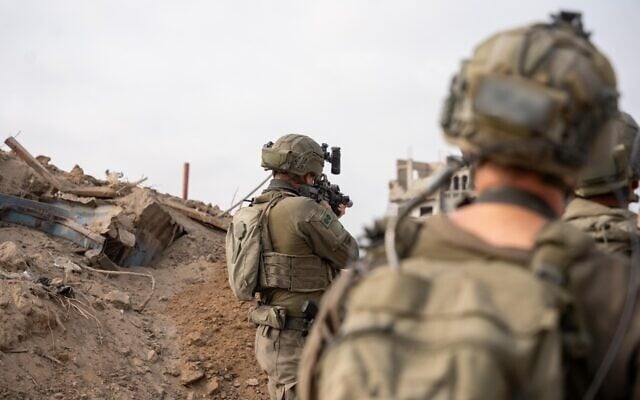 IDF troops operate in the Zeitoun neighborhood of Gaza City, in a handout photo issued on August 15, 2025. (Israel Defense Forces)
IDF troops operate in the Zeitoun neighborhood of Gaza City, in a handout photo issued on August 15, 2025. (Israel Defense Forces)In one incident, the military said the 7th Brigade troops spotted several operatives who fired an RPG at a tank, without causing injuries. The operatives were then eliminated in a strike, according to the IDF.
The Nahal Brigade troops have meanwhile been working on clearing the area of Hamas infrastructure and establishing control. The army said the Nahal soldiers killed several operatives who were spotted planting bombs, and others who approached the forces.
Additionally, the division’s 990th Artillery Regiment has provided the ground troops with covering fire. Ahead of the offensive and during it, the IDF says the artillery unit shelled terror infrastructure and killed several operatives, including a Hamas platoon commander in the Zeitoun Battalion.
The Israeli Air Force has also been provided support, striking Hamas sites and operatives in the area.
Ahead of the operation, the IDF issued multiple evacuation warnings for Palestinian civilians who were residing in the area.
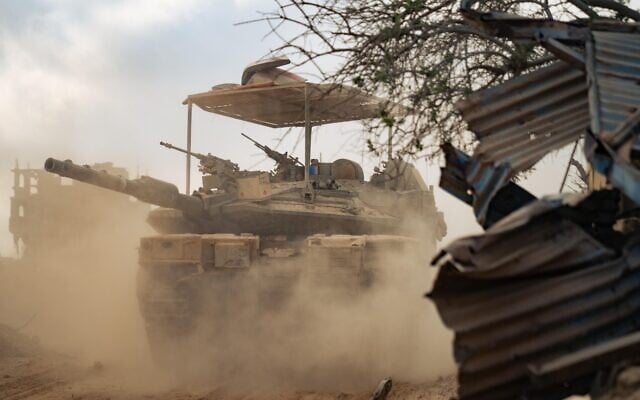 IDF troops operate in the Zeitoun neighborhood of Gaza City, in a handout photo issued on August 15, 2025. (Israel Defense Forces)
IDF troops operate in the Zeitoun neighborhood of Gaza City, in a handout photo issued on August 15, 2025. (Israel Defense Forces)On Wednesday, Gaza’s Hamas-run civil defense agency said Israeli airstrikes on Gaza City had intensified, with the residential neighborhoods of Zeitoun and Sabra hit “with very heavy airstrikes targeting civilian homes, possibly including high-rise buildings.”
IDF seals major tunnel network
Additionally, the IDF said Friday that seven kilometers (4.3 miles) worth of Hamas tunnels in northern Gaza’s Beit Hanoun were sealed with concrete.
The IDF said the engineering effort took place over the past four weeks, amid an offensive against Hamas in the town.
Over 20,000 cubic meters of concrete were pumped into the Hamas tunnel network in Beit Hanoun, using a “dedicated system” that included a 4.5-kilometer-long (2.8-mile-long) pipeline running from the border fence near the community of Netiv Haasara to the “heart” of the underground passages, the IDF said.
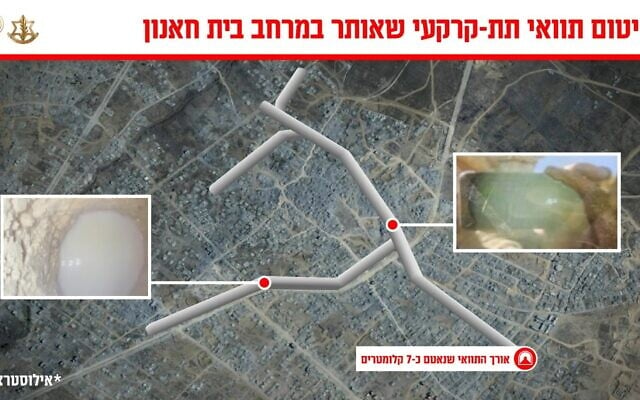 This illustration shows an approximate map of a Hamas tunnel network in northern Gaza’s Beit Hanoun, in a graphic issued by the IDF on August 15, 2025. (Israel Defense Forces)
This illustration shows an approximate map of a Hamas tunnel network in northern Gaza’s Beit Hanoun, in a graphic issued by the IDF on August 15, 2025. (Israel Defense Forces)“The operation was made possible thanks to precise engineering planning, combining advanced technological capabilities and innovative methods used for the first time, which led to the complete sealing of the tunnel,” the military said.
Simultaneously, the IDF said another 2.4 kilometers (1.5 miles) of tunnels in Beit Hanoun were blown up by combat engineers using standard demolition methods.
“The two combined efforts led to a significant blow to the Beit Hanoun Battalion and led to its operational defeat,” the army added.
Sealing tunnels with concrete can be a cheaper and less risky alternative to blowing them up, although it takes longer to carry out.
UN: At least 1,760 killed while seeking aid since May
Also on Friday, the UN human rights office said that at least 1,760 Palestinians have been killed while seeking aid in Gaza since late May, a jump of several hundred since its last published figure at the beginning of August.
“Since 27 May, and as of 13 August, we have recorded that at least 1,760 Palestinians have been killed while seeking aid; 994 in the vicinity of GHF (Gaza Humanitarian Foundation) sites and 766 along the routes of supply convoys. Most of these killings were committed by the Israeli military,” the agency’s office for the Palestinian territories said in a statement.
That compares with a figure of 1,373 killed, the office reported on August 1, a jump of 387 fatalities in just over two weeks.
The IDF has acknowledged firing warning shots toward those who pose a threat to soldiers, while insisting that Hamas is inflating the death count at each of these incidents. It has not provided alternative figures, though, and hasn’t allowed journalists to freely operate in Gaza in order to verify the toll.
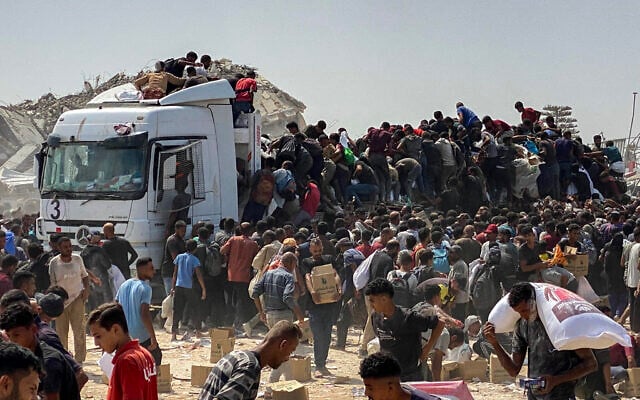 Displaced Palestinians carry food parcels as they raid trucks carrying humanitarian aid in Khan Younis, in the southern Gaza Strip on August 9, 2025. (AFP)
Displaced Palestinians carry food parcels as they raid trucks carrying humanitarian aid in Khan Younis, in the southern Gaza Strip on August 9, 2025. (AFP)Those firing the warning shots are soldiers not trained in crowd control the way police officers are and aren’t provided with non-lethal means to employ in Gaza while they are carrying out other combat missions.
While the majority of reported deaths have taken place en route to GHF sites, the past several weeks have seen double the casualties near the convoys of the UN and other international organizations.
This appears to be tied to the ongoing chaos surrounding UN convoys, which are quickly overrun by desperate Gazans before they make it to warehouses or distribution sites. Nearly 90% of UN aid is not reaching intended destinations throughout Gaza, according to UN figures.
The latest update comes as Gaza’s Hamas-run civil defense agency says at least 23 people were killed by Israeli fire on Friday, including 12 who were waiting for humanitarian aid.
The Israeli military said it is looking into the reports when contacted for comment.
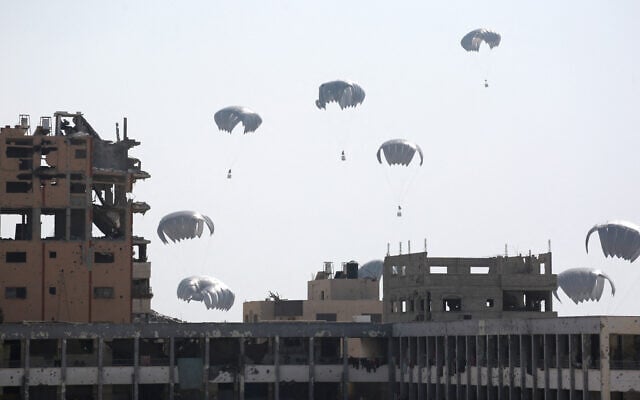 Aid packages parachute down near Jabalia in the northern Gaza Strip on August 14, 2025. (Bashar TALEB / AFP)
Aid packages parachute down near Jabalia in the northern Gaza Strip on August 14, 2025. (Bashar TALEB / AFP)Airdrops and aid trucks continue to enter Gaza
As Israel has ramped up aid efforts in the face of reports of malnutrition and starvation in Gaza, aircraft from the United Arab Emirates, Jordan, Germany, Belgium, France, Italy, and — for the first time — Singapore airdropped 127 pallets of humanitarian aid in the Gaza Strip on Friday, according to the IDF.
Each pallet contains around one ton of food.
Israel re-adopted a policy of allowing aid airdrops on July 26, amid mounting international criticism over the hunger crisis in Gaza. But airdrops are only able to deliver a small fraction of what can come into Gaza by land. They also pose safety risks for the civilians who can be hit by the packages from above.
Alongside the airdrops, over 310 trucks carrying humanitarian aid entered the Gaza Strip Thursday through the Kerem Shalom and Zikim crossings, Israel’s Coordinator of Government Activities (COGAT) said.
According to COGAT, more than 390 trucks worth of aid were also collected by the United Nations and other international organizations from the Gaza side of the crossings yesterday to be distributed.
 Displaced Palestinians attempt to fill water tanks in the Mawasi area of Gaza on August 14, 2025. (AFP)
Displaced Palestinians attempt to fill water tanks in the Mawasi area of Gaza on August 14, 2025. (AFP)Another 119 pallets of aid — about 4-6 trucks worth — were airdropped by Jordan, the UAE, Germany, Belgium, Italy and France in Gaza Thursday, according to the IDF.
The UN has said 600 trucks of aid need to be distributed each day in order to properly feed the Strip’s roughly two million people.
Additionally, COGAT said that “tankers of UN fuel entered for the operation of essential humanitarian systems” Thursday. It also says it facilitated the entry and exit of aid workers rotating in and out of Gaza.
The war began on October 7, 2023, when thousands of Hamas-led terrorists invaded Israel, killing some 1,200 people and taking 251 hostages.
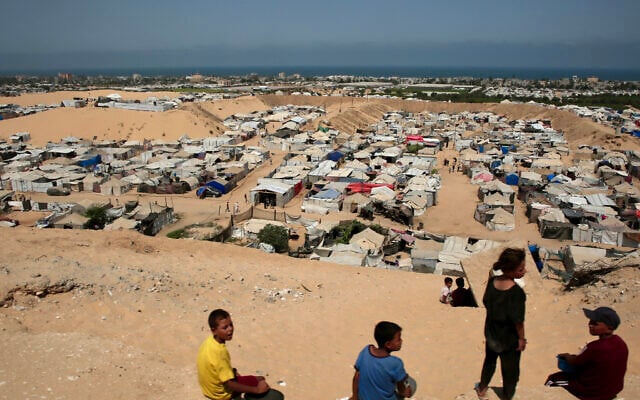 A general view of tents housing displaced Palestinians in the Mawasi area of Khan Younis in the southern Gaza Strip, on August 14, 2025. (AFP)
A general view of tents housing displaced Palestinians in the Mawasi area of Khan Younis in the southern Gaza Strip, on August 14, 2025. (AFP)Terror groups in Gaza still hold 50 hostages, of whom 20 are believed to be alive, while 28 have been confirmed dead, and the government has expressed “grave concern” about the remaining two.
The Hamas-run Gaza health ministry says more than 60,000 people in the Strip have been killed or are presumed dead in the fighting so far, though the toll cannot be verified and does not differentiate between civilians and fighters. Israel says it has killed some 20,000 combatants in battle as of January and another 1,600 terrorists inside Israel during the October 7 onslaught.
Israel has said it seeks to minimize civilian fatalities and stresses that Hamas uses Gaza’s civilians as human shields, fighting from civilian areas including homes, hospitals, schools and mosques.
Israel’s toll in the ground offensive against Hamas in Gaza and in military operations along the border with the Strip stands at 459. The toll includes two police officers and three Defense Ministry civilian contractors. Link
UN says 13,000 children treated for malnutrition in Gaza in July as aid trickles in
Humanitarian agency says vast majority of aid trucks raided en route, but notes that despite challenges, food prices have dropped and kitchens are producing more hot meals
Close to 13,000 children were admitted to treatment centers in Gaza due to acute malnutrition in July amid severe food shortages, the UN Office for the Coordination of Humanitarian Affairs said in a periodic update on the situation in the war-torn Gaza Strip.
The update released Wednesday painted a dire picture for the children of the Strip, with increased cases of acute malnutrition and hospitalizations putting the enclave’s overburdened and tattered healthcare system under even more strain.
According to OCHA, the total number of severe acute malnutrition cases diagnosed in children in July rose to 2,800, or roughly 22 percent of all childhood malnutrition cases diagnosed last month.
While in most cases, acute malnutrition can be treated at any of the 106 outpatient sites dedicated to it across the Gaza Strip, OCHA said cases in which hospitalization is required have become increasingly challenging.
In total, 129 cases of severe acute malnutrition with complications that required hospitalization were diagnosed in July. This marked a sharp uptick in cases, as between the months of January to June, there were just 215 cases requiring hospitalization.
Despite the rising demand, there are still only five sites across the entire Gaza Strip at which children with complications of severe acute malnutrition can be stabilized and treated, OCHA said. Two of the stabilization sites are located in Gaza City, one is in Deir al-Balah, and the final two are located in Khan Younis.
In total, there are only 43 beds available across the five combined sites.
The report did not confirm the ages of the children diagnosed with malnutrition over the past month.
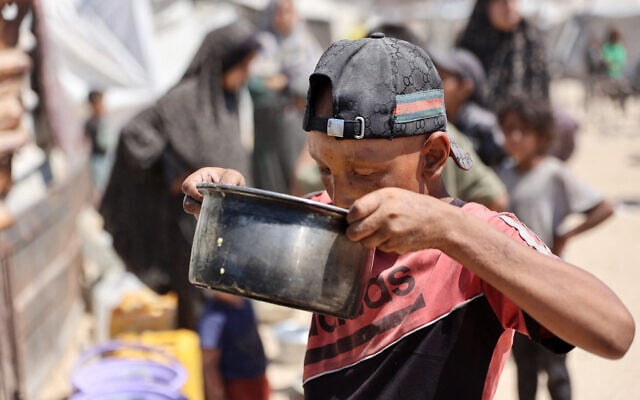 A Palestinian boy drinks lentil soup that he obtained at a food distribution point in Gaza City on August 1, 2025. (Photo by Omar AL-QATTAA / AFP)
A Palestinian boy drinks lentil soup that he obtained at a food distribution point in Gaza City on August 1, 2025. (Photo by Omar AL-QATTAA / AFP)Gaza’s Hamas-run health ministry has said that 42 children have died of malnutrition-related causes since July 1, along with 129 adults, although those numbers could not be independently verified.
Widening its purview to examine the state of the humanitarian conditions across the entire Strip, the OCHA report painted a bleak picture.
It said that while the UN’s World Food Programme collected 1,012 trucks carrying 13,000 metric tons of food from Gaza’s border crossings in July, only 10 of them ever reached their intended warehouses once inside the Strip.
The remainder were “offloaded en route,” it said, although it was unclear whether this was referring to organized theft or to looting by crowds of hungry civilians.
In theory, OCHA said, the Food Security Sector believes there is enough food in or en route to Gaza to feed the population of roughly 2.1 million people for the next three months. But in reality, “the risk of spoilage and infestation of the stranded food supplies has significantly increased, and some of them are reaching their expiry dates.”
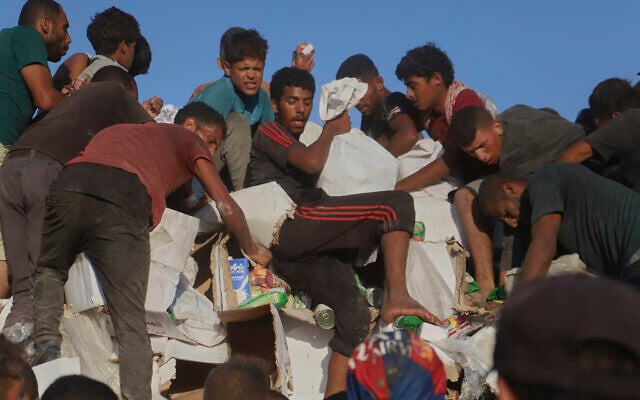 Palestinians struggle to get food and humanitarian aid from the back of a truck as it moves along the Morag corridor near Rafah, in the southern Gaza Strip, August 4, 2025. (AP Photo/ Mariam Dagga)
Palestinians struggle to get food and humanitarian aid from the back of a truck as it moves along the Morag corridor near Rafah, in the southern Gaza Strip, August 4, 2025. (AP Photo/ Mariam Dagga)It said that FSS was calling for “large-scale humanitarian assistance with guaranteed safe, unimpeded and sustained access” to ensure that the full amount of food earmarked for Gaza truly reaches its intended destination.
Images of starving Gazans drew international outrage last month and heaped pressure on Israel until, on July 27, it announced measures to allow more aid into the Gaza Strip.
But aid agencies have warned that the slightly eased measures — including restarting the practice of airdropping supplies into Gaza — are not enough to fill the gap created by long months of little to no aid entering the enclave, and that on top of that, only a fraction of what is sent ends up entering the Strip.
Israel strongly denies limiting aid supplies and accuses Hamas of exploiting deliveries to boost its military capabilities.
On Thursday, dozens of aid groups signed a statement alleging that Israel was refusing to let a number of international NGOs distribute aid in Gaza, leaving millions of dollars’ worth of food and other assistance sitting in warehouses and putting future aid operations at risk.
Separately, the Haaretz newspaper reportedthat massive amounts of humanitarian aid have been spilling off trucks in Gaza and going to waste because the IDF is not allowing organizations to properly secure the cargo.
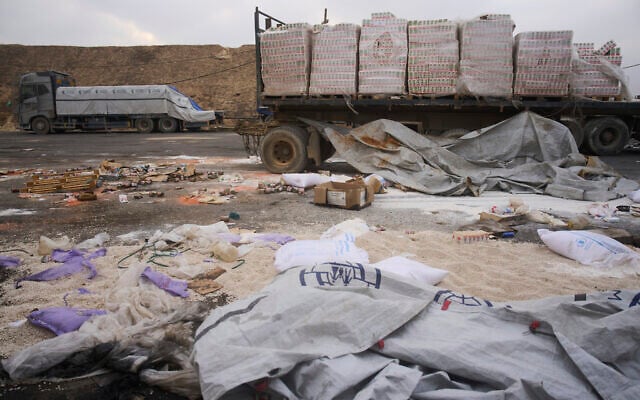 Damaged trucks carrying humanitarian aid for Palestinians in Gaza are parked next to the border with the Gaza Strip near the Kissufim crossing in southern Israel, Wednesday, Aug. 13, 2025. (AP/Ariel Schalit)
Damaged trucks carrying humanitarian aid for Palestinians in Gaza are parked next to the border with the Gaza Strip near the Kissufim crossing in southern Israel, Wednesday, Aug. 13, 2025. (AP/Ariel Schalit)According to the report, Israeli soldiers at the Kerem Shalom Crossing rush aid workers to quickly load cargo onto trucks that are regularly delayed for hours at a time. Because the food isn’t tied down well and aid seekers are not given ample time to identify the route being used, aid has become easy to loot when the trucks reach areas where civilians are waiting.
The poorly secured aid also leads to large amounts of it spilling over, as the roads used by aid groups have been badly damaged by the war.
Even satellite images can show long trails of flour extending from the Kerem Shalom Crossing.
COGAT, the Defense Ministry body that coordinates aid, said in response to the signed statement from aid workers that Israel invests “considerable efforts” in aid distribution, and does not place “any quantitative limit” on the number of trucks entering the Gaza Strip.
The agency did not address specific questions about aid shipment volumes, nor did it address Haaretz’s claim regarding Israeli restrictions on properly fastening aid to trucks.
Ingredient prices drop, access to hot meals increases
But even with large amounts of aid failing to reach their intended destination, and the dire warnings that the aid is falling far short of what is needed, the impact of the eased regulations could be felt in the Strip, OCHA said, as “different types of food have started to trickle into the markets.”
As a result, the eased restrictions have lowered the price of some basic ingredients, it said, with the price of sugar dropping to NIS 30-40 ($9-12) per kilogram as of August 10, down from a peak price of NIS 600 ($180) per kilogram earlier this year.
And it wasn’t just ingredients that were becoming more available for Gaza’s civilians — the amount of hot meals prepared by humanitarian groups was increasing too, OCHA said.
It said that as of August 10, 324,000 meals were being prepared each day at 81 community kitchens across the Gaza Strip, up from 259,000 two weeks earlier.
Of that number, around 99,000 are distributed to people in the north of the Strip, and 225,000 to those in the center and south.
While trending in the right direction, OCHA reiterated that those numbers fall far short of the roughly one million meals that were distributed across the Strip daily back in April.
“People continue to suffer from extremely imbalanced diets that lack essential nutrients, increasing the risk of acute malnutrition,” it cautioned.
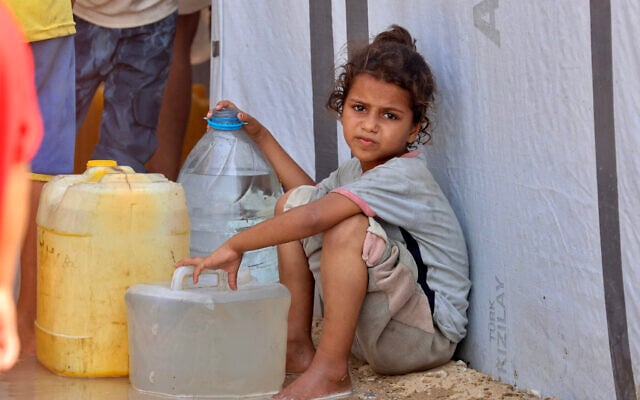 A girl sits by water containers while displaced Palestinians wait to collect water in the Mawasi area of southern Gaza, on August 14, 2025. (Photo by AFP)
A girl sits by water containers while displaced Palestinians wait to collect water in the Mawasi area of southern Gaza, on August 14, 2025. (Photo by AFP)Accessing humanitarian aid in the Strip continues to be dangerous, even though the quantity has somewhat increased in recent weeks, with near-daily reports of mass-casualty incidents near aid sites persisting.
On Thursday, a spokesman for Gaza’s Hamas-run civil defense agency said six people had been killed while waiting for humanitarian aid.
While the spokesman did not say whether the alleged incident occurred near an aid truck or at a designated aid distribution site, the majority of such incidents have been reported to occur near aid sites run by the US- and Israel-backed Gaza Humanitarian Foundation.
The United Nations says more than 1,300 people have been killed trying to obtain aid supplies in the enclave since the GHF began operating in May, most of them shot by Israeli forces operating near GHF sites.
Israel does not often comment on individual reports of shootings near aid sites, but the IDF has acknowledged in the past that it fires warning shots at crowds that get too close to its soldiers. Israel has also said the UN tallies exaggerated, though it hasn’t provided alternative casualty figures. Link
IDF says small surveillance drone crashed in Gaza City
A small Israeli military surveillance drone crashed in the Rimal neighborhood of Gaza City this morning, according to Palestinian media and the IDF.
The military says the unmanned aerial vehicle, a Skylark 3 model, was on a reconnaissance mission when it made an “emergency landing in the northern Gaza Strip following a technical malfunction.”
There is no fear of information leaking from the device, the IDF adds.
The Skylark is a tactical surveillance drone created by Elbit Systems and operated by the IDF’s Artillery Corps. Many Skylark UAVs have crashed in hostile territory over the years. video
**There is nothing more important than getting them home! NOTHING!**
“I’ve never met them,But I miss them. I’ve never met them,but I think of them every second. I’ve never met them,but they are my family. BRING THEM HOME NOW!!!”
There is no victory until all of the hostages are home!אין נצחון עד שכל החטופים בבית
Red Alerts - Missile, Rocket, Drone (UAV - unmanned aerial vehicles), and Terror Attacks and Death Announcements
*
Gaza and the South

IDF strikes Hezbollah sites, as Katz claims Aoun’s government responsible for ceasefire violations
Israeli Air Force fighter jets struck a Hezbollah facility and a tunnel belonging to the terror group near the Beaufort Castle in southern Lebanon a short while ago, the IDF says.
The military says the existence of the site is a violation of the ceasefire between Israel and Lebanon.
“We will not budge from our policy of maximum enforcement and will not allow threats to arise against the residents of the north and all citizens of Israel,” Defense Minister Israel Katz says in a statement on the strikes.
In a message to Lebanon’s new President Joseph Aoun, Katz says Israel views Beirut as “directly responsible for enforcing Lebanon’s sovereignty and upholding the ceasefire agreement.”
The Lebanese government has been working to disarm Hezbollah, but has sometimes been criticized for not doing so effectively. Critics of Israeli policy, however, argue that carrying out such strikes too regularly without giving the Lebanese government the opportunity to dismantle Hezbollah on its own may risk undermining the first-ever government that has expressed a genuine willingness to address the issue.
- Former Israeli Hostage Negotiator says Israel has gone too far
More than 100 organisations have signed a joint letter calling on Israel to stop the "weaponisation of aid" into Gaza, as "starvation deepens".
Humanitarian groups, including Oxfam and Médecins Sans Frontières (MSF), say they are increasingly being told they are "not authorised" to deliver aid, unless they comply with the stricter Israeli regulations.
Joining Andrea to discuss this with his unique insight is former Israeli Hostage Negotiator, Gershon Baskin. listen to interview with Dr. Gershon Baskin
- Israeli peace activist: International community must act to stop this war
Commenting on Israel's Gaza City occupation plan, Israeli peace activist Gershon Baskin says that while a large majority of Israeli citizens oppose continuing the war, they lack the political power to effect change. As the Israeli government remains determined to press on, it is a critical moment for the international community to take responsibility and act to stop it. short interview with Dr. Gershon Baskin
Inside Israel, the movement to stop Netanyahu’s Gaza war is gaining momentum

Although the suffering of the Palestinian population has capturing the attention of media and leaders worldwide, voices expressing empathy for Gazans are still a minority in Israel.
On Saturday evening, during TV primetime, activists from Standing Together, a Jewish-Arab movement for peace, stormed the live Israeli broadcast of Big Brother. Three young women, wearing “We’re Leaving Gaza!” T-shirts, sat on the stage while the anchor was heard saying: “Everything’s fine, everything’s fine.” They, on the contrary, wanted the Israeli public watching the show to know that everything isn’t fine – far from it. Hauled away, one managed to shout: “The war has to stop!”
One of the protesters, Ariel Dukelski, told Democrat TV: “Inside Big Brother’s house, the show with the highest ratings on TV today, the residents are arguing about the cigarette budgets and ice pops, when only an hour and a half away, children are dying of hunger, there is mass extermination and the hostages are left to die.”
The protests – which the activists vow to continue – have escalated after the decision last week by the Israeli security cabinet to “take control of Gaza City.” While the suffering of the Palestinian population is capturing the attention of media and leaders around the world, voices such as the ones of Standing Together, expressing empathy for the civilians of Gaza, are a minority in Israel.
However, the majority of Israelis – 74 per cent, according to a July poll from Channel 12 – want to see the end of the war in exchange for the release of the remaining hostages. The recent videos of two young emaciated hostages, Rom Braslavsky and Evyatar David, have revived a sense of urgency. The families of the hostages, exhausted but nevertheless determined to do everything possible to save the lives of their loved ones, are calling for a nationwide strike on Sunday.
High tech companies, the Israel Bar Association, universities and some municipalities have announced they would take part in the strike. “It is our moral duty,” said a statement by the University of Haifa.
Momentum is building as Israel buckles under the weight of 22 months of war. Women’s organizations are banding together and speaking out. “The fighters in Gaza, our sons, are asking us to call for the end of this war,” Moran Michel from the new coalition Wars End When Mothers Rise told me. “This war serves no security or diplomatic purpose, only a political agenda.”
According to media reports, Israel Defense Forces Chief of Staff Eyal Zamir has also pushed back, arguing that the plan to take over Gaza City might be a “death trap” for soldiers and further endanger the hostages. Reserve and retired Israel Air Force pilots are also calling for the war to end.

Enav Zangauker, mother of hostage Israeli Matan Zangauker, cries by a fake coffin during a protest in Tel Aviv.JACK GUEZ/AFP/GETTY IMAGES
However, during a news conference last Sunday, Israeli Prime Minister Benjamin Netanyahu made a point of showing not everyone in Israel opposes his military strategy. He read a note a reservist soldier wrote to his wife: “We are very strong, motivated and capable to do any amount of reserved duty necessary to beat Hamas.” The Prime Minister’s aim was to show that even though the streets might become packed over the next few days with people opposing the war, and specifically, the plan to invade Gaza City, there are also soldiers who support him and his decisions. “We are able to finish Hamas and we will finish Hamas,” said Mr. Netanyahu.
In an interesting twist, his far-right minister Bezalel Smotrich, who advocates for a total occupation of Gaza, expressed his disappointment with Mr. Netanyahu’s plan. “I have lost faith that the Prime Minister is able and willing to lead the IDF to a decisive victory,” Mr. Smotrich said. The plan appears to leave the door open for a partial hostage deal, which could halt the military operation. Nevertheless, Mr. Smotrich is not threatening to quit the government. For now, Mr. Netanyahu remains politically strong and in a position to ignore the loud voices rising from across the country.
At last Saturday’s weekly rally for the hostages, organizers said 100,000 people took to the streets of Tel Aviv and other cities. This Saturday, a significant turnout is expected, and Sunday’s general strike will likely get wide support.
Every Israeli wishes Hamas would end the war by releasing the hostages, disarming and relinquishing power in the Gaza Strip, but they also know such outcomes are unrealistic from a terrorist jihadi organization. Therefore, they are turning to their government to find a way to end to the longest war in Israel’s history. Not only has it failed to achieve its objectives by now – destroying Hamas and bringing back all the hostages – but it has also sunk the standing of Israel internationally.
Large numbers will be out on the streets this weekend. The government will hear, but it doesn’t mean it will listen. link October 7 did a lot of things in Israel, among them fear, anger, hate, loss and a host of other feelings. In addition, the scenes filmed and broadcast by the barbaric Hamas terrorists who committed the atrocities of October 7, showed both those atrocities and the reactions and actions of Gazans in the streets of Gaza against our hostages as well as Gazans who were not part of the Hamas/Islamic Jihad massacre, come into Israeli communities killing, attacking, looting, taking hostages and stealing the bodies of Israelis who were killed. These scenes have caused a multitude of negative feelings and attitudes about Palestinians and Gazans specifically, such as the belief that no one in Gaza is innocent and the desire to flatten Gazan and get rid of all Gazans, one way or another. Unfortunately, those feelings are felt by many, but fortunately, not by all. Most Israelis have been very comfortable not seeing the actual destruction done in Gaza by our bombings and other actions. For a long time, many Israelis could only feel, think about and contemplate our own suffering and we were not mentally capable of dealing with or thinking about the suffering on the other side, especially while we still have hostages being held by the Hamas terrorists. The Israeli press also shielded and still shields us from the horrors and war crimes being committed in our names in Gaza. But that is changing. Eyes are being opened by many and those are trying to open the eyes of the rest of the public. The numbers are still small but growing steadily and even those who still haven't opened their eyes to the horrors of Gaza, we are all together in wanting the war to end. Those numbers keep on growing and growing and we are all making ourselves heard by all. The problem is the same as it has been since the beginning. There is one person who makes the decisions and he is not willing to end the war until it will serve his political survival needs or until Trump will get fed up with him and tell Netanyahu to end the war now. We know that Netanyahu doesn't give a damn about the lives of the hostages or the soldiers he keeps sending the Gaza. Neither does Trump. But Trump's base cares about what they see happening in Gaza, so Trump told Netanyahu to fix it. Without a cabinet meeting, without any vote or discussion, Netanyahu unilaterally changed the policy that he and his cabinet set regarding humanitarian aid all because Trump told him to. Trump is the one person Netanyahu cannot say no to and we are all waiting for Trump to finally lose his patience with Netanyahu and tell him to end the war. Until that happens, things will drag on and on, with the hostages' and soldiers' lives not having any value or worth the Netanyahu other than to serve his purposes for political survival.
Despite denials, Israel-South Sudan talks on relocating Gazans reportedly ongoing
Talks about resettling Gazans from the war-torn Strip to South Sudan have been ongoing between Jerusalem and the troubled African nation, despite a fervent denial issued by the latter government, three sources familiar with the matter tell Reuters.
The sources, who have knowledge of the matter and are speaking on condition of anonymity, say no agreement has been reached, but that talks between South Sudan and Israel were ongoing.
The plan, if carried further, would envisage people moving from an enclave shattered by almost two years of war with Israel to a nation in the heart of Africa riven by years of political and ethnically-driven violence.
Arab and world leaders have rejected the idea of moving Gaza’s population to any country. Palestinians say that would be like another “Nakba” (catastrophe) when hundreds of thousands fled or were forced out during Israel’s War of Independence in 1948.
The three sources say the prospect of resettling Palestinians in South Sudan was raised during meetings between Israeli officials and South Sudanese Foreign Minister Monday Semaya Kumba when he visited the country last month.
Their account appeared to contradict South Sudan’s foreign ministry, which on Wednesday dismissed earlier reports on the plan as “baseless.”
The ministry was not immediately available to respond to the sources’ assertions on Friday.
Israeli Deputy Foreign Minister Sharren Haskel, who visited the South Sudanese capital Juba this week, told Reuters that those discussions had not focused on relocation.
“This is not what the discussions were about,” she said when asked if any such plan had been discussed.
“The discussions were about foreign policy, about multilateral organizations, about the humanitarian crisis, the real humanitarian crisis happening in South Sudan, and about the war,” she said, referring to her talks with Juba officials.
Netanyahu, who met Kumba last month, has said Israel is in touch with a few countries to find a destination for Palestinians who want to leave Gaza. He has consistently declined to provide further details
- The Region and the World
Netahyahu has become a ‘problem,’ says Danish PM
Danish Prime Minister Mette Frederiksen says Israeli leader Benjamin Netanyahu has become a “problem,” adding she will try to put pressure on Israel over the Gaza war as her country currently holds the EU presidency.
“Netanyahu is now a problem in himself,” Frederiksen says in an interview with the Jyllands-Posten daily, adding that the Israeli government is going “too far.”
The center-right leader slams the “absolutely appalling and catastrophic” humanitarian situation in Gaza and new settlement project in the West Bank.
“We are one of the countries that wants to increase pressure on Israel, but we have not yet obtained the support of EU members,” she says.
Frederiksen adds that she wants to consider “political pressure, sanctions, whether against settlers, ministers, or even Israel as a whole,” referring to trade or research sanctions.
“We are not ruling anything out in advance. Just as with Russia, we are designing the sanctions to target where we believe they will have the greatest effect,” adds Frederiksen, whose country is not among those who have said they will recognize the Palestinian state. link The Danish PM said it exactly, Netanyahu is the problem. He was the problem that brought us October 7 and he is the problem that we still have 50 hostages in captivity and the war continues with no end in site. NETANYAHU IS THE PROBLEM!
Acronyms and Glossary
ICC - International Criminal Court in the Hague
IJC - International Court of Justice in the Hague
MDA - Magen David Adom - Israel Ambulance Corp
PA - Palestinian Authority - President Mahmud Abbas, aka Abu Mazen
PMO- Prime Minister's Office
UAV - Unmanned Aerial vehicle, Drone. Could be used for surveillance and reconnaissance, or be weaponized with missiles or contain explosives for 'suicide' explosion mission
Join my Whatsapp update group https://chat.whatsapp.com/IQ3OtwE6ydxBeBAxWNziB0
Twitter - @LonnyB58 Bluesky - @lonny-b.bsky.social
My blogs in The Times of Israel my blogs
Substack - https://lonnyb.substack.com/
Twitter - @LonnyB58
My blogs in The Times of Israel my blogs
Substack - https://lonnyb.substack.com/




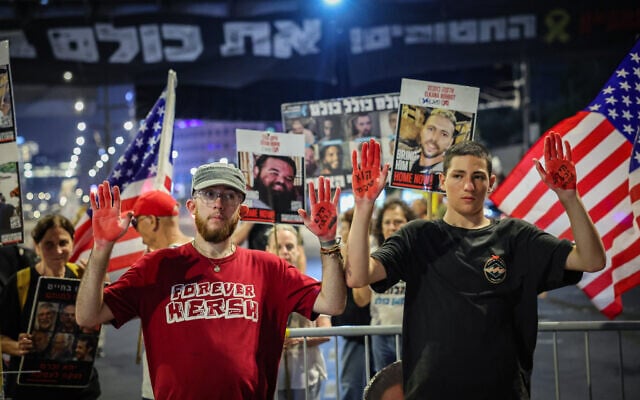







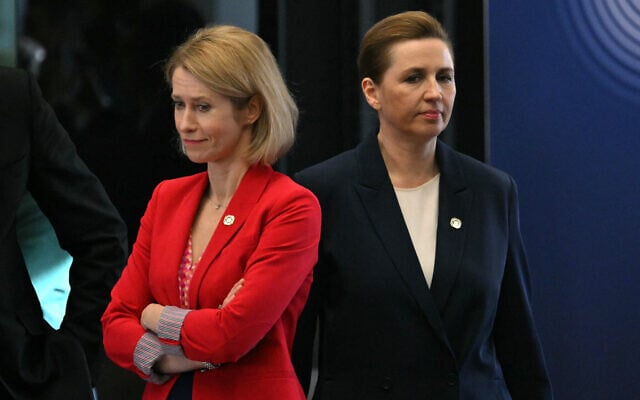


Comments
Post a Comment